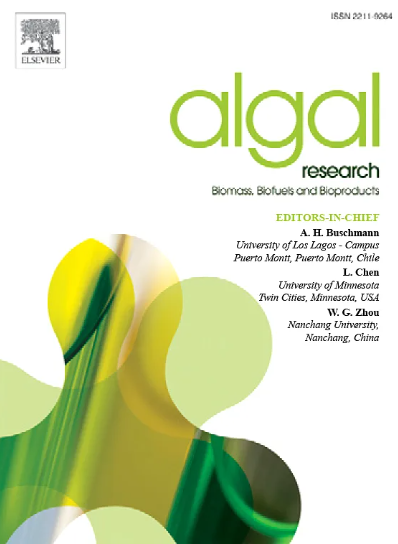温度对杏仁藻产氧量和生长的影响
IF 4.6
2区 生物学
Q1 BIOTECHNOLOGY & APPLIED MICROBIOLOGY
Algal Research-Biomass Biofuels and Bioproducts
Pub Date : 2024-11-12
DOI:10.1016/j.algal.2024.103795
引用次数: 0
摘要
使氧气产量最大化的最佳温度和辐照度分别为 39.3 ℃ 和 512.5 μmol 光子-m-2-s-1。这些数值是通过光呼吸测定法获得的,该方法是一种在实验室规模上测量微藻光合作用和呼吸速率的快速方法。在这些条件下,阿尔梅里尔藻的总产氧率为 246.23 mg 氧-生物量-1-h-1。当培养温度控制在 39.3 °C,每天 1 小时时,阿尔米里藻的日产氧量从 3129.5 毫克氧-生物量-1 增加到 3778.5 毫克氧-生物量-1。然而,将温度长时间保持在 39.3 °C,会对光合装置造成损害。使用实验室规模的气泡柱验证了这一点。将细胞加热 2 小时后,损伤是可逆的,但将培养温度保持在 39.3 °C,持续 3 小时,则会导致不可逆转的损伤,光合作用性能下降 6%。控制微藻培养物的过热对最大限度地提高生长至关重要。此外,高温暴露的持续时间也应纳入生长过程并加以考虑。本文章由计算机程序翻译,如有差异,请以英文原文为准。
Effect of temperature on the oxygen production capacity and growth of scenedesmus almeriensis
The optimal temperature and irradiance to maximise oxygen production were 39.3 °C and 512.5 μmol photons·m−2·s−1, respectively. These values were obtained by photorespirometry, which is a quick method to measure the photosynthetic and respiration rates of microalgae at a laboratory scale. With these conditions, the global oxygen production rate of S. almeriensis was 246.23 mgoxygen·gbiomass−1·h−1. When the culture temperature was controlled at 39.3 °C for 1 h per day, the daily oxygen production capacity of S. almeriensis increased from 3129.5 mgoxygen·gbiomass−1 to 3778.5 mgoxygen·gbiomass−1. However, keeping the temperature at 39.3 °C for a longer time period caused a damage to the photosynthetic apparatus. This was validated using laboratory-scale bubble columns. The damage was reversible when heating the cells for <2 h, but keeping the temperature of the culture at 39.3 °C for 3 h led to an irreversible damage and a 6 % decrease in the photosynthetic performance. Controlling the overheating of microalgal cultures is crucial to maximise growth. In addition, the duration of the exposure to high temperatures should also be included into growth and taken in consideration.
求助全文
通过发布文献求助,成功后即可免费获取论文全文。
去求助
来源期刊

Algal Research-Biomass Biofuels and Bioproducts
BIOTECHNOLOGY & APPLIED MICROBIOLOGY-
CiteScore
9.40
自引率
7.80%
发文量
332
期刊介绍:
Algal Research is an international phycology journal covering all areas of emerging technologies in algae biology, biomass production, cultivation, harvesting, extraction, bioproducts, biorefinery, engineering, and econometrics. Algae is defined to include cyanobacteria, microalgae, and protists and symbionts of interest in biotechnology. The journal publishes original research and reviews for the following scope: algal biology, including but not exclusive to: phylogeny, biodiversity, molecular traits, metabolic regulation, and genetic engineering, algal cultivation, e.g. phototrophic systems, heterotrophic systems, and mixotrophic systems, algal harvesting and extraction systems, biotechnology to convert algal biomass and components into biofuels and bioproducts, e.g., nutraceuticals, pharmaceuticals, animal feed, plastics, etc. algal products and their economic assessment
 求助内容:
求助内容: 应助结果提醒方式:
应助结果提醒方式:


